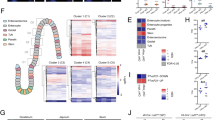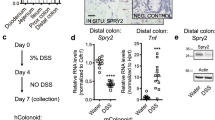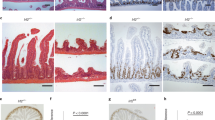Abstract
Intestinal microfold cells (M cells) are an enigmatic lineage of intestinal epithelial cells that initiate mucosal immune responses through the uptake and transcytosis of luminal antigens. The mechanisms of M-cell differentiation are poorly understood, as the rarity of these cells has hampered analysis. Exogenous administration of the cytokine RANKL can synchronously activate M-cell differentiation in mice. Here we show the Ets transcription factor Spi-B was induced early during M-cell differentiation. Absence of Spi-B silenced the expression of various M-cell markers and prevented the differentiation of M cells in mice. The activation of T cells via an oral route was substantially impaired in the intestine of Spi-B-deficient (Spib−/−) mice. Our study demonstrates that commitment to the intestinal M-cell lineage requires Spi-B as a candidate master regulator.
This is a preview of subscription content, access via your institution
Access options
Subscribe to this journal
Receive 12 print issues and online access
$209.00 per year
only $17.42 per issue
Buy this article
- Purchase on Springer Link
- Instant access to full article PDF
Prices may be subject to local taxes which are calculated during checkout







Similar content being viewed by others
Accession codes
References
Kraehenbuhl, J.P. & Neutra, M.R. Epithelial M cells: differentiation and function. Annu. Rev. Cell Dev. Biol. 16, 301–332 (2000).
Neutra, M.R., Mantis, N.J. & Kraehenbuhl, J.P. Collaboration of epithelial cells with organized mucosal lymphoid tissues. Nat. Immunol. 2, 1004–1009 (2001).
Neutra, M.R., Frey, A. & Kraehenbuhl, J.P. Epithelial M cells: gateways for mucosal infection and immunization. Cell 86, 345–348 (1996).
Bockman, D.E. & Cooper, M.D. Pinocytosis by epithelium associated with lymphoid follicles in the bursa of Fabricius, appendix, and Peyer's patches. An electron microscopic study. Am. J. Anat. 136, 455–477 (1973).
Owen, R.L. & Jones, A.L. Epithelial cell specialization within human Peyer's patches: an ultrastructural study of intestinal lymphoid follicles. Gastroenterology 66, 189–203 (1974).
Hase, K. et al. Uptake through glycoprotein 2 of FimH+ bacteria by M cells initiates mucosal immune response. Nature 462, 226–230 (2009).
Terahara, K. et al. Comprehensive gene expression profiling of Peyer's patch M cells, villous M-like cells, and intestinal epithelial cells. J. Immunol. 180, 7840–7846 (2008).
Hase, K. et al. Distinct gene expression profiles characterize cellular phenotypes of follicle-associated epithelium and M cells. DNA Res. 12, 127–137 (2005).
Verbrugghe, P. et al. Murine M cells express annexin V specifically. J. Pathol. 209, 240–249 (2006).
Hase, K. et al. The membrane-bound chemokine CXCL16 expressed on follicle-associated epithelium and M cells mediates lympho-epithelial interaction in GALT. J. Immunol. 176, 43–51 (2006).
Hase, K. et al. M-Sec promotes membrane nanotube formation by interacting with Ral and the exocyst complex. Nat. Cell Biol. 11, 1427–1432 (2009).
Barker, N. & Clevers, H. Leucine-rich repeat-containing G-protein-coupled receptors as markers of adult stem cells. Gastroenterology 138, 1681–1696 (2010).
Gebert, A., Fassbender, S., Werner, K. & Weissferdt, A. The development of M cells in Peyer's patches is restricted to specialized dome-associated crypts. Am. J. Pathol. 154, 1573–1582 (1999).
Ebisawa, M. et al. CCR6hiCD11cint B cells promote M-cell differentiation in Peyer's patch. Int. Immunol. 23, 261–269 (2011).
Golovkina, T.V., Shlomchik, M., Hannum, L. & Chervonsky, A. Organogenic role of B lymphocytes in mucosal immunity. Science 286, 1965–1968 (1999).
Kernéis, S., Bogdanova, A., Kraehenbuhl, J.P. & Pringault, E. Conversion by Peyer's patch lymphocytes of human enterocytes into M cells that transport bacteria. Science 277, 949–952 (1997).
Taylor, R.T. et al. Lymphotoxin-independent expression of TNF-related activation-induced cytokine by stromal cells in cryptopatches, isolated lymphoid follicles, and Peyer's patches. J. Immunol. 178, 5659–5667 (2007).
Knoop, K.A. et al. RANKL is necessary and sufficient to initiate development of antigen-sampling M cells in the intestinal epithelium. J. Immunol. 183, 5738–5747 (2009).
Jensen, J. et al. Control of endodermal endocrine development by Hes-1. Nat. Genet. 24, 36–44 (2000).
Gerbe, F. et al. Distinct ATOH1 and Neurog3 requirements define tuft cells as a new secretory cell type in the intestinal epithelium. J. Cell Biol. 192, 767–780 (2011).
Katz, J.P. et al. The zinc-finger transcription factor Klf4 is required for terminal differentiation of goblet cells in the colon. Development 129, 2619–2628 (2002).
Bastide, P. et al. Sox9 regulates cell proliferation and is required for Paneth cell differentiation in the intestinal epithelium. J. Cell Biol. 178, 635–648 (2007).
Mori-Akiyama, Y. et al. SOX9 is required for the differentiation of paneth cells in the intestinal epithelium. Gastroenterology 133, 539–546 (2007).
Jenny, M. et al. Neurogenin3 is differentially required for endocrine cell fate specification in the intestinal and gastric epithelium. EMBO J. 21, 6338–6347 (2002).
Su, G.H. et al. The Ets protein Spi-B is expressed exclusively in B cells and T cells during development. J. Exp. Med. 184, 203–214 (1996).
Schotte, R. et al. The transcription factor Spi-B is expressed in plasmacytoid DC precursors and inhibits T-, B-, and NK-cell development. Blood 101, 1015–1023 (2003).
Jang, M.H. et al. Intestinal villous M cells: an antigen entry site in the mucosal epithelium. Proc. Natl. Acad. Sci. USA 101, 6110–6115 (2004).
Rumbo, M., Sierro, F., Debard, N., Kraehenbuhl, J.-P. & Finke, D. Lymphotoxin β receptor signaling induces the chemokine CCL20 in intestinal epithelium. Gastroenterology 127, 213–223 (2004).
Mach, J., Hshieh, T., Hsieh, D., Grubbs, N. & Chervonsky, A. Development of intestinal M cells. Immunol. Rev. 206, 177–189 (2005).
Pappo, J. & Ermak, T.H. Uptake and translocation of fluorescent latex particles by rabbit Peyer's patch follicle epithelium: a quantitative model for M cell uptake. Clin. Exp. Immunol. 76, 144–148 (1989).
Garrett-Sinha, L.A. et al. PU.1 and Spi-B are required for normal B cell receptor-mediated signal transduction. Immunity 10, 399–408 (1999).
McSorley, S.J., Asch, S., Costalonga, M., Reinhardt, R.L. & Jenkins, M.K. Tracking salmonella-specific CD4 T cells in vivo reveals a local mucosal response to a disseminated infection. Immunity 16, 365–377 (2002).
Salazar-Gonzalez, R.M. et al. CCR6-mediated dendritic cell activation of pathogen-specific T cells in Peyer's patches. Immunity 24, 623–632 (2006).
Ray, D. et al. Characterization of Spi-B, a transcription factor related to the putative oncoprotein Spi-1/PU.1. Mol. Cell. Biol. 12, 4297–4304 (1992).
Su, G.H. et al. Defective B cell receptor-mediated responses in mice lacking the Ets protein, Spi-B. EMBO J. 16, 7118–7129 (1997).
DeKoter, R.P. et al. Regulation of follicular B cell differentiation by the related E26 transformation-specific transcription factors PU.1, Spi-B, and Spi-C. J. Immunol. 185, 7374–7384 (2010).
Schotte, R., Nagasawa, M., Weijer, K., Spits, H. & Blom, B. The ETS transcription factor Spi-B is required for human plasmacytoid dendritic cell development. J. Exp. Med. 200, 1503–1509 (2004).
Jedlicka, P. & Gutierrez-Hartmann, A. Ets transcription factors in intestinal morphogenesis, homeostasis and disease. Histol. Histopathol. 23, 1417–1424 (2008).
Ng, A.Y.-N. et al. Inactivation of the transcription factor Elf3 in mice results in dysmorphogenesis and altered differentiation of intestinal epithelium. Gastroenterology 122, 1455–1466 (2002).
Gregorieff, A. et al. The ets-domain transcription factor Spdef promotes maturation of goblet and paneth cells in the intestinal epithelium. Gastroenterology 137, 1333–1345 (2009).
Zhao, X. et al. CCL9 is secreted by the follicle-associated epithelium and recruits dome region Peyer's patch CD11b+ dendritic cells. J. Immunol. 171, 2797–2803 (2003).
Bjerknes, M. & Cheng, H. Gastrointestinal stem cells. II. Intestinal stem cells. Am. J. Physiol. Gastrointest. Liver Physiol. 289, G381–G387 (2005).
Gulig, P.A., Doyle, T.J., Hughes, J.A. & Matsui, H. Analysis of host cells associated with the Spv-mediated increased intracellular growth rate of Salmonella typhimurium in mice. Infect. Immun. 66, 2471–2485 (1998).
Carter, P.B. & Collins, F.M. Experimental Yersinia enterocolitica infection in mice: kinetics of growth. Infect. Immun. 9, 851–857 (1974).
Acknowledgements
We thank Z. Guo, Y. Obata, Y. Oohara, Y. Fujimura, M. Ohmae, C. Uetake, Y. Usami and S. Kimura for technical support; T. Kawai for electron microscopy analysis; and H. Matsui (Kitasato University) for S. Typhimurium. Supported by RIKEN (T.Kan., D.T. and I.S.), the Kishimoto Foundation (K.Ho., I.S., H.H. and T.Kai.), the Ministry of Education, Culture, Sports, Science and Technology of Japan (21022049 to K.Ha.; 20060033, 21022048 and 21117003 to T.Kai.; and 20113003 to H.O.), the Japan Society for the Promotion of Science (22689017 to K.Ha.; 23790550 to T.Kan.; 21390155 to H.O.; and 20390146, 23390124 and 18590483 to T.Kai.), the Japan Science and Technology Agency (K.Ha.), The Japan Science Society (K.Ha.), The Takeda Science Foundation (H.O.), The Mitsubishi Foundation (H.O.), The Uehara Memorial Foundation (T.Kai.), the US National Institutes of Health (DK64730 to I.R.W.) and the Bill & Melinda Gates Foundation (OPP1006977 to I.R.W.).
Author information
Authors and Affiliations
Contributions
I.R.W., K.Ha. and H.O. conceived of the study; T.Kan. designed and did the experiments, analyzed data and wrote the manuscript; K.Ha. contributed to adoptive-transfer experiments and data analysis; D.T. and Y.K. helped with flow cytometry; S.F. and T.J. helped with experiments involving infection with S. Typhimurium; K.N. and A.S. did expression analyses; K.Ho., I.S., H.H. and T.Kai. generated Spib−/− mice; K.A.K., N.K. and I.R.W. developed the protocol for treatment with RANKL; M.S. and K.T. helped with electron microscopy; O.Y. and T.Kat. provided human PP samples; S.J.M. provided SM1 mice; K.Ha. and I.R.W. edited the manuscript; and H.O. directed the research and edited the manuscript.
Corresponding authors
Ethics declarations
Competing interests
The authors declare no competing financial interests.
Supplementary information
Supplementary Text and Figures
Supplementary Figures 1–10 and Tables 1–3 (PDF 18635 kb)
Rights and permissions
About this article
Cite this article
Kanaya, T., Hase, K., Takahashi, D. et al. The Ets transcription factor Spi-B is essential for the differentiation of intestinal microfold cells. Nat Immunol 13, 729–736 (2012). https://doi.org/10.1038/ni.2352
Received:
Accepted:
Published:
Issue Date:
DOI: https://doi.org/10.1038/ni.2352
This article is cited by
-
Cross-species single-cell transcriptomic analysis reveals divergence of cell composition and functions in mammalian ileum epithelium
Cell Regeneration (2022)
-
Cell fate specification and differentiation in the adult mammalian intestine
Nature Reviews Molecular Cell Biology (2021)
-
A further study on a disturbance of intestinal epithelial cell population and kinetics in APC1638T mice
Medical Molecular Morphology (2021)
-
Organoids in immunological research
Nature Reviews Immunology (2020)
-
Microfold cell-dependent antigen transport alleviates infectious colitis by inducing antigen-specific cellular immunity
Mucosal Immunology (2020)



